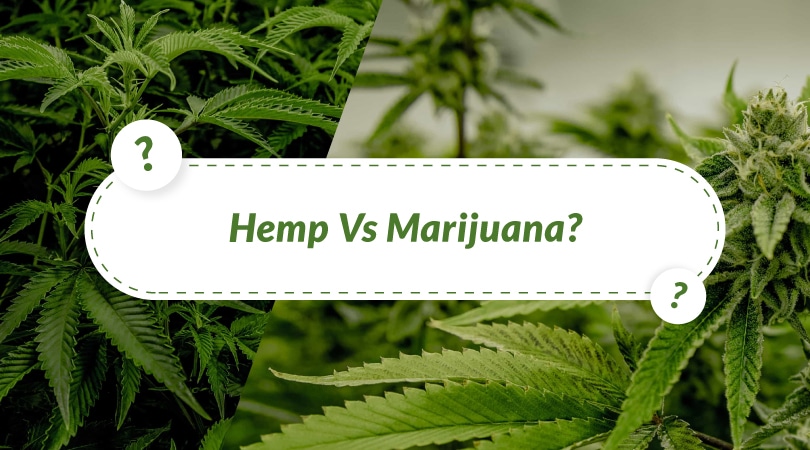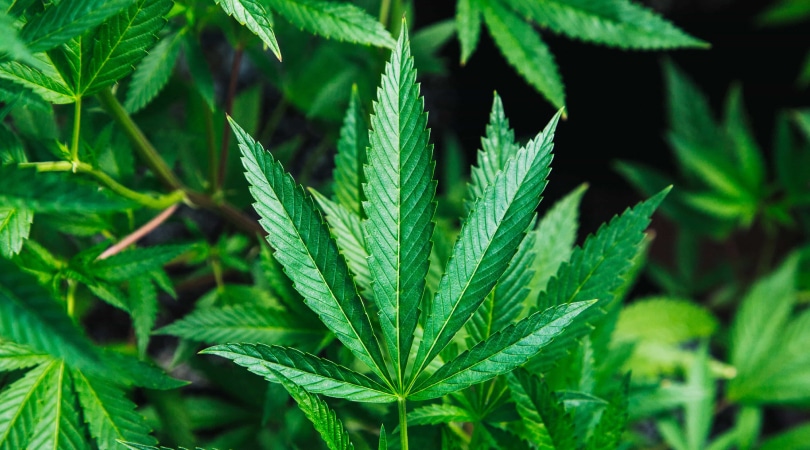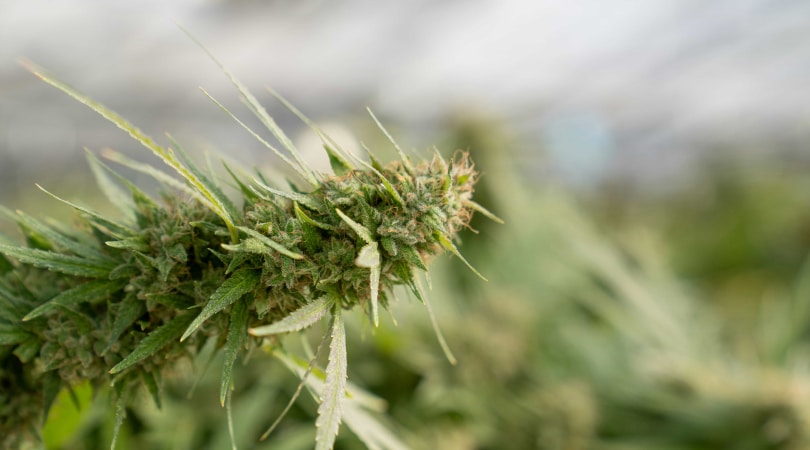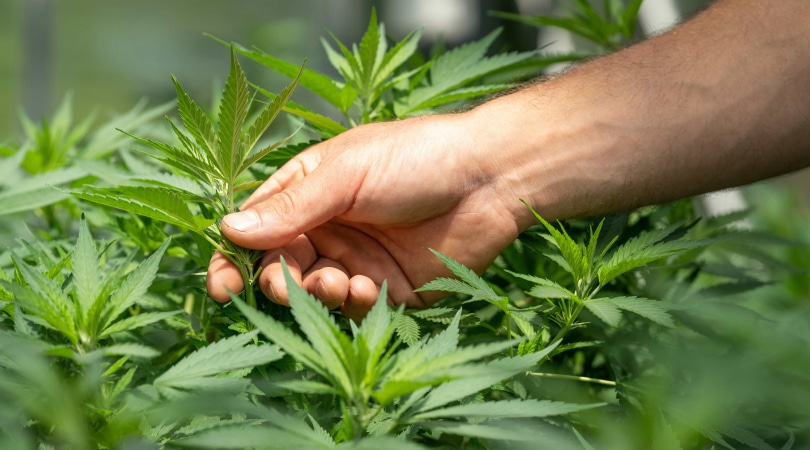
Hemp vs Marijuana Difference
When you enter the world of cannabis, you’ll soon discover there are many words and names that people throw around like Indica, Sativa, CBD, THC, Hemp, Marijuana, Cannabis… And figuring out which option is best for you can be confusing. The truth is it is a good idea to understand some basics before deciding to jump in to try any products.
No need to get overwhelmed. Here, we tell you everything you need to know about the difference between marijuana, cannabis, and hemp: what they are, their uses, their legal status, and the CBD and THC in them.

Cannabis Genus – What Is It?
Plants are classified into groups based on their taxonomy, which is a way of organizing living things. In this system, a genus is a category that is above species, meaning it groups different species together.
The Cannabis genus, originally from Asia, blooms every year and has leaves divided into smaller parts with jagged edges.
There is some disagreement about the number of species in this genus. Usually, it is accepted that the Cannabis genus is made up of three species: Cannabis sativa, Cannabis indica, and Cannabis ruderalis.
However, some researchers believe that Cannabis ruderalis is part of Cannabis sativa, while others think all three are subspecies of Cannabis sativa, or that Cannabis sativa is the only species.
What Is Marijuana?
Normally, the word “marijuana” is used to talk about the variety that gets you high, meaning it has psychoactive effects.
According to the Agriculture Improvement Act of 2018, “marijuana” is defined as the cannabis variety “with a delta-9 tetrahydrocannabinol concentration of more than 0.3 percent on a dry weight basis.”
Other terms like “weed,”, “mary jane”, “pot,” or “cannabis” are also used to refer to the same type of cannabis plant.
Marijuana plants are bushy, with broad leaves and a height of about 6.5 feet. They are usually bred to be female because, unlike their male counterpart, they grow flowers rich in THC, which is a key ingredient for both therapeutical and recreational use.
“Marijuana” Name Roots & Controversy
There is some controversy regarding the use of the word “marijuana,” as some link it to its prohibition campaign and the racial profiling of the war on drugs. This is why some claim that it is better to use the term “cannabis” instead of “marijuana”.
However, Violet Cavendish, from The Marijuana Policy Project, highlighted the importance of recognizing this history instead of erasing the term, as it helps understand how policies targeted minorities.

On the other hand, Professor Isaac Campos’ research points out that there were many terms used to call what we know as cannabis according to their specific effects and ways to consume it. He mentions that Americans adopted “marijuana” to describe a milder, cigarette-smoking method from Mexico and that there is no evidence of a conspiracy against cannabis from that time.
That said, you can do your own research to decide whether or not to use that word. Staying informed about the historical context and showing respect for diverse perspectives is key.
What Is Hemp?
Hemp is the cannabis variation that doesn’t have psychoactive effects, as it has 0.3% or less of THC. It is grown for industrial and commercial purposes.
The hemp plant is fragrant and sturdy, it can grow up to 20 ft. Its leaves are hand-shaped, and its flowers are greenish-yellow. Female plants have seed flowers in long clusters, and male plants have pollen flowers in branched clusters.

Where Does Indica & Sativa Come Into Hemp vs Marijuana Differences?
There have been strong debates around the classification of cannabis varieties, especially regarding the hemp strain. According to this research paper from 2020, the classification of hemp has changed a lot over time.
Scientists disagreed on how many species of Cannabis there are and how to divide them. At first, they used plant shapes and where they grew, but later, they used new lab techniques.
The main problem is that wild Cannabis plants can breed with each other, causing constant changes.
The current agreement is that both hemp and marijuana come from Cannabis sativa and that Cannabis indica is a subspecies of Cannabis sativa.
Check the taxonomy of the United States Department of Agriculture for Cannabis sativa and Cannabis indica.
Marijuana Uses
Marijuana is commonly used for both recreational and medicinal purposes, mainly thanks to its higher THC content, including:
- Recreational Use: Many people use marijuana to experience what we call “getting high”.
- Pain Relief: It has been suggested that Marijuana could help alleviate different types of pain, including chronic pain from conditions like arthritis and multiple sclerosis.
- Nausea Relief: According to anecdotal testimonies, marijuana could reduce nausea.
- Migraine Reduction: Some people use marijuana to help reduce the frequency and intensity of migraines.
- Anxiety and Stress Relief: Marijuana is usually associated with reducing anxiety and stress.
- Improving Sleep: For those with insomnia or other sleep disorders, marijuana is believed to improve sleep quality and duration.
Keep in mind that many of the medicinal uses of marijuana have not been scientifically confirmed, as many are still in the early research stages.
Hemp Uses
Hemp has a wide range of uses, from building material to nutrition. Here are some of its uses:
- Food: Hemp seeds can be eaten raw, ground, or made into hemp milk. Hemp oil can be used for cooking and in food products, as it is high in unsaturated fatty acids.
- Fiber: Hemp fiber is used to make textiles, ropes, fabrics, and industrial materials. It is also used in clothing, shoes, accessories, and homewares.
- Building Material: Hemp is used in construction for its lightweight, mold resistance, and breathability. It can be used in various forms, including ropes, strands, plastics, and wood alternatives.
- Paper: Hemp paper is made from hemp pulp thanks to its longer fibers, and higher tear resistance compared to wood pulp. It can be recycled more times and does not require toxic bleaching.
- CBD Uses: Since hemp has more CBD than marijuana, it is used to create CBD oil and other CBD products, which are suggested to contribute to wellness and relief, such as helping with depression, cold symptoms, gastritis, and even menopause.
As with marijuana, scientific research on the uses of CBD is still in the initial stages and requires further studies.
CBD and THC Levels in Marijuana and Hemp
Generally speaking, hemp is known for its higher CBD levels compared to marijuana.
The percentage of CBD in hemp can vary significantly, ranging from 6.4% to 52.4%, depending on the type and strain of hemp.
Marijuana, on the other hand, is higher on THC (the component that gets you high). Its strains usually range from 0.3% to 30% THC, with an average of 18% THC and below 1% CBD.
Legal Status of Hemp and Marijuana in the U.S
Hemp
The Agriculture Improvement Act of 2018, also known as the 2018 Farm Bill, legalized hemp throughout the U.S. This means that it was removed from the Controlled Substances Act, allowing its cultivation and sale at the federal level.
However, despite federal legalization, the regulation of hemp and hemp-derived products is mostly left to each state. This has led to a complex legal situation, with some states enacting stricter rules, particularly concerning cannabinoids derived from hemp.
Some states are imposing “total THC” limits, which consider the combined amount of all THC variants, not just delta-9 THC. This means that products containing higher levels of other THC variants may fall outside the legal limits, even if they comply with federal guidelines.
Marijuana
Some states allow marijuana for medical use, while others also permit it for recreational purposes. However, at the federal level, marijuana is classified as a Schedule I drug, which means it’s illegal.
Even though federal law prohibits marijuana, states where it’s legal have their own rules. This is why marijuana is legal for recreational use in 24 states, and in 38 for medicinal purposes.
That said, with new research and business opportunities coming up, the legality of both cannabis varieties is quickly changing, opening up the path for the cultivation, sale, and use of marijuana and hemp.
The Bottom Line
If you’re considering purchasing CBD or THC products, it’s key that you understand the differences between marijuana and hemp. While both come from the same plant, their effects vary due to their different levels of CBD and THC. Also, remember that hemp-derived products contain minimal THC and are federally legal, while marijuana-derived products have higher THC levels and their legality varies by state.
Visit our store to find the perfect product for you among a wide range of high-quality CBD and THC options.
References
Clark, M. (2020). Marijuana isn’t just a word. A 420 exploration into “marijuana’s” roots and other commonly used terms for Mary Jane from ganja to grass. The News House. Retrieved from https://www.thenewshouse.com/highstakes/marijuana-is-more-than-a-word/
Drug Enforcement Administration (DEA), Department of Justice. (2020). Implementation of the Agriculture Improvement Act of 2018. Retrieved from https://www.federalregister.gov/documents/2020/08/21/2020-17356/implementation-of-the-agriculture-improvement-act-of-2018#:~:text=The%20Agriculture%20Improvement%20Act%20of%202018%2C%20Public%20Law%20115%2D334,of%20tetrahydrocannabinols%20under%2021%20U.S.C
Koren A., Sikora V., Kiprovski B., Brdar-Jokanović M., Aćimović M., Konstantinović B., Latković D. Controversial taxonomy of hemp. Genetika. 2020;52:1–13. https://doi.org/10.2298/GENSR2001001K
Rivas, R. (2023). Why some people believe ‘marijuana’ is a racist word, and why it doesn’t offend me. Missouri Independent. Retrieved from https://missouriindependent.com/2023/05/02/why-some-people-believe-marijuana-is-a-racist-word-and-why-it-doesnt-offend-me/
Zheljazkov, V. D., Sikora, V., Dincheva, I., Kačániová, M., Astatkie, T., Semerdjieva, I. B., & Latkovic, D. (2020). Industrial, CBD, and Wild Hemp: How Different Are Their Essential Oil Profile and Antimicrobial Activity? Molecules (Basel, Switzerland), 25(20), 4631. https://doi.org/10.3390/molecules25204631
